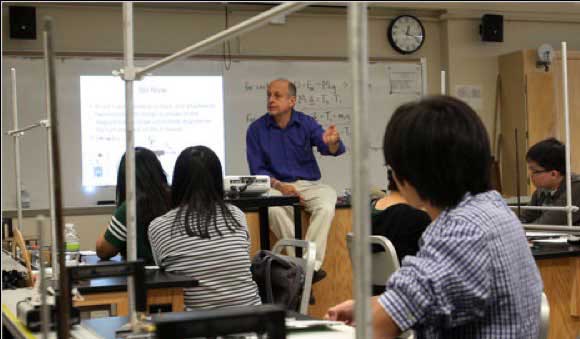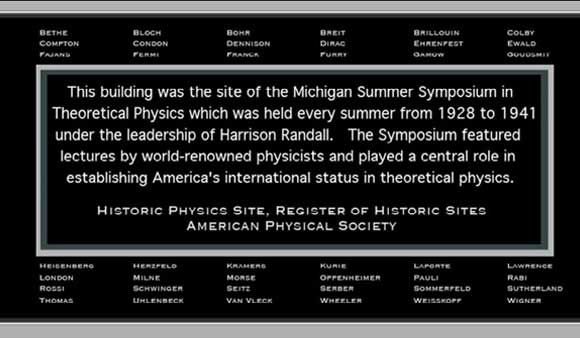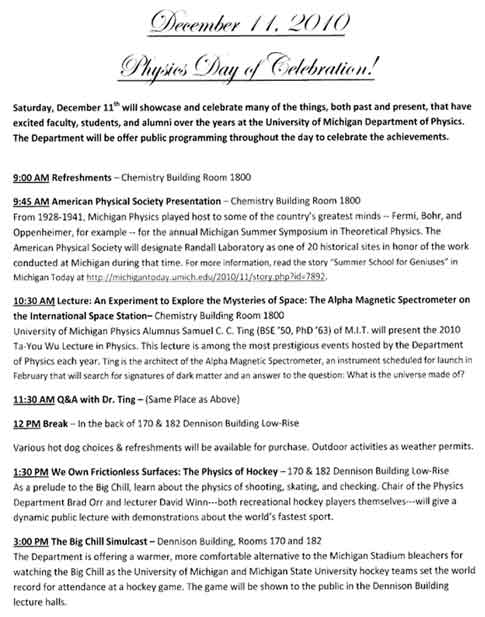Report on Historic Sites Committee (HSC) Activities
By Ben Bederson
In 2004 Alan Chodos proposed that our Forum form a committee to commemorate sites of particular importance to the development of physics in America. With the strong support of the then Chair of FHP, Michael Riordan, an ad hoc APS committee was formed, later to become a standing committee of the APS. As noted on the HSC website, “The purpose of the Historic Sites initiative is to raise public awareness of physics…The initiative will also benefit physicists by increasing their own awareness of important past scientific advances… When a site is chosen, a ceremony is arranged at which a plaque is presented, often by a member of the APS presidential line.”
Chodos has stated “I was inspired by seeing the numerous plaques scattered throughout Europe commemorating the birthplaces and achievements of writers, musicians, scientists, etc.”
The first Chair of the committee, John Rigden, established the “ledger of historic sites”, the signing of which is part of the presentation ceremony (Fig. 1).

Fig. 1. Page from the ledger of historic sites
John presided over the committee from 2005-2009, during which time he arranged for 17 citations. I added four more in 2010. The original committee was: John Rigden (Chair), Gordon Baym, Sidney Drell, Millie Dresselhaus, and Gerald Holton. When Baym, Drell and Dresselhaus rotated off, they were replaced by Dave Jackson, Steve Weinberg, and Katharine Gebbie. The current committee consists of Spencer Weart, Kurt Gottfried, Dave Jackson, Ruth Howes, and myself as Chair. An excellent earlier report on the committee’s activities is contained in a Back Page story in APS News April 2010 by Rigden.
Listed below is the complete set of official citations, appearing on the accompanying plaques, for the 21 awards up to the year 2010.
Awardees, 2005-2010
1. Benjamin Franklin, The Franklin Center, Philadelphia. “Benjamin Franklin was a printer, a scientist, and a statesman. His interest in electrical phenomena led to important discoveries and a range of terms used today. With his famous kite experiment, he demonstrated that lightning is a stream of electrified air now called a plasma.”
2. The Michelson-Morley experiment, Case Western Reserve Univesity. “On this campus in 1887, Albert A. Michelson (1852-1931), Professor of Physics at Case, and Edward W. Morley (1838-1923), Professor of Chemistry at Western Reserve, performed a precise optical experiment designed to measure the Earth’s rotation through the ether. The experiment became world famous because, surprisingly, no motion was detected. Later, in 1905, this unexpected result was explained by Albert Einstein’s Special Theory of Relativity. Michelson, in 1907, was the first American to win the Nobel Prize in physics.”
3. The Compton Experiment, Arthur Holly Compton, and Washington University in Saint Louis. “In 1921- 22, Arthur Holly Compton conducted X-ray scattering experiments in Eads Hall on the campus of Washington University in Saint Louis. Compton’s results showed that the wavelength of the scattered X-ray was larger than that of the incident X-ray. He interpreted his surprising results in terms of Albert Einstein’s 1905 particle theory of light which had been rejected by most physicists. The vivid clarity of Compton’s experiments convinced physicists that light had a particle nature. For this experiment, Compton won the Nobel Prize for physics in 1927.”
4. Henry Augustus Rowland and The Johns Hopkins University. “Henry Augustus Rowland (1848-1901) was Professor of Physics at The Johns Hopkins University from 1875 to 1901. Here he invented the concave diffraction grating and developed it into a tool for precision spectroscopy in astronomy and physics.”
5. Robert A. Millikan and The University of Chicago. “Robert Millikan (1868-1953) was researcher and professor of physics at the University of Chicago from 1892 to 1921. Near this site, he conducted his famous oil-drop experiments that established the electrical charge of the electron.”
6. Bell Labs and the Transistor. “Here at Bell Labs on December 12, 1947, John Bardeen and Walter H. Brattain made one of the greatest inventions of all time—the transistor—which is now part of virtually every electronic device. William Shockley further refined the transistor and, in 1950, built the fundamental architecture in use today. In 1956, Bardeen, Brittain, and Shockley won the Nobel Prize in physics for this work.”
7. Josiah Willard Gibbs and Yale University. “Josiah Willard Gibbs (1839- 1903) was Professor of Mathematical Physics at Yale University from 1871 to 1902. On this site, Gibbs expanded the domain of thermodynamics and gave it a solid foundation in statistical mechanics, a subject he helped create.”
8. Joseph Henry and The Albany Academy. “Joseph Henry (1797-1878) was a student (1813 to 1823) and professor of mathematics and natural philosophy (1826 to 1832) at The Albany Academy. Near this location, Henry began his research in electricity and magnetism and, in 1832, he discovered magnetic self-induction.”
9. MIT Radiation Laboratory and the Development of Radar during WWII. “At this location, the MIT Radiation Laboratory was established in the fall of 1940 to develop microwave radar systems. Radar quickly took its place in all areas of World War II and played a decisive role in the Allied victory. The laboratory closed on December 31, 1945.”
10. The University of Illinois at Urbana- Champaign and the BCS Theory of Superconductivity. “In this building, the home of the University of Illinois’ Physics Department from 1909 to 1959, John Bardeen, Leon Cooper, and J. Robert Schrieffer created the ‘BCS’ theory of superconductivity, a great achievement in theoretical physics, in 1956-57. For their work, they were awarded the 1972 Nobel Prize in Physics.”
11. The first cyclotron, nuclear and particle physics, The University of California, Berkeley. “At this site, Ernest O. Lawrence invented a new type of particle accelerator and, in 1930-31, he and M. Stanley Livingston built the first successful cyclotron. With this cyclotron and its successors, the University of California, Berkeley became a major center for nuclear and particle physics.”
12. The birthplace of the Physical Review, Cornell University. “In 1893 the journal Physical Review was founded near this site by three Cornell physicists, Edward Nichols, Ernest Merritt, and Frederick Bedell. This building was the journal’s home from 1906 until 1913. By the mid-1930s, Physical Review was one of the world’s leading physics journals.”
13. Where the first antiparticle was discovered—The California Institute of Technology. “Near this site, in August 1932, Carl David Anderson photographed the track of a cosmic-ray particle in his cloud chamber. He identified this particle as the positron—the first known antiparticle.”
14. Discovery of the cosmic microwave background radiation, Bell Laboratories, Holmdel. “With this large horn antenna, Arno Penzias and Robert Wilson discovered the cosmic background radiation in 1964. This unexpected discovery, the first evidence that the universe began with the Big Bang, ushered in experimental cosmology.”
15. Columbia University. “In recognition of Isidor Isaac Rabi (1898-1988) for his discovery of the magnetic resonance method in 1938 and in recognition of the Columbia Physics Department for its contributions to the advancement of physics.”
16. Jefferson Physical Laboratory, Harvard University. “In recognition of the Jefferson Physical Laboratory, dedicated in 1884, as the oldest university building erected in America to pursue physics research, and for the many scientific advances made by its faculty.”
17. McGill University. “At this location, Ernest Rutherford and Frederick Soddy, during 1901-1903, correctly explained radioactivity as emission of particles from the nucleus and established the laws of spontaneous transmutation of the elements.”
18. HRL Laboratories. “At this location Theodore H. Maiman and co-workers constructed the world’s first working laser, on May 16, 1960. Made of synthetic ruby, it was the harbinger of a technological revolution that has forever changed the world.”
19. Shelter Island Conference. “At this site a small meeting of theoretical physicists met soon after World War II and in a burst of pent up energy after the war years doing military science attacked several of the most important problems of the time to achieve dramatic understanding of some fundamental questions in quantum physics.”
20. Bronx High School of Science. “In this school generations of students from every economic and cultural background encountered their first experiences which would lead to great achievements in science and technology, as witnessed by the seven Nobel Prizes awarded in physics between 1972 and 2005, the largest number of any high school in America.”
21. Michigan Summer Symposium in Theoretical Physics, 1928-1941, University of Michigan. “This plaque honors the Michigan Summer Symposium in Theoretical Physics 1928-1941 under the leadership of Harrison Randall. During this period, virtually every world-renowned physicist lectured at the symposium, which played a critical role in helping America achieve international status in theoretical physics.”
To give a flavor of the kinds of celebrations that recipients organize, I describe here the two latest events. On October 15, 2010 we honored the New York City Bronx High School of Science, for its role in educating generations of scientists, and in particular for having had the good fortune of graduating no fewer than seven physics Nobel laureates. The school dedicated that day to the event, with a special convocation for the entire school, where the award was presented to the principal, Valerie Reidy. One of the Nobel laureates, David Politzer, travelled to the school from Cal Tech to spend the day there, where he met with students and teachers privately and in class, even working with some students on lab experiments. The event was described in a NY Times article Oct 16 (Fig. 2).

Fig. 2. New York Times article highlighting Nobel laureate David Politzer’s classroom visit.
David Politzer, who shared the 2004 Nobel Prize in Physics, visited his alma mater, the Bronx High School of Science, on Friday.
A Nobel Laureate Returns Home to Bronx Science (NY Times, Oct 16, 2010)
David Politzer donned a pair of safety goggles Friday morning and smiled as two soccer-playing robots whizzed around the floor of a classroom at the Bronx High School of Science.
The robots—products of the school’s robotics teams, the Sciborgs and the Fe Maidens (after the elemental symbol for iron)—had a tough audience. Dr. Politzer, a Bronx Science alumnus, was a 2004 recipient of the Nobel Prize in Physics.
The school has not one but seven Nobel laureates in physics among its alumni—more than any other high school in America. Dr. Politzer’s visit was part of a ceremony designating the school a Historic Physics Site, an honor bestowed by the American Physical Society.
Dr. Politzer, Bronx Science class of 1966, won the Nobel with David J. Gross and Frank Wilczek for work in quantum chromodynamics. They found that the closer quarks—subatomic particles that make up protons and neutrons—come to one another, the weaker their interaction.
Addressing students on Friday, Dr. Politzer described quantum mechanics as “monkey business” and “mumbo jumbo.”
The American Physical Society, which has recognized several sites a year since 2004, had cited the California laboratory where the first working laser was constructed, the site in Shelter Island, N.Y., where a 1946 conference on quantum mechanics was held, and many research universities, but never a high school.
“It struck us as being extraordinary,” said Benjamin Bederson, chairman of the society’s historic sites committee.
Bronx Science’s other Nobel winners are Leon N. Cooper, class of 1947, Nobel in 1972; Sheldon L. Glashow and Steven Weinberg, both class of 1950, Nobel in 1979; Melvin Schwartz, class of 1949, Nobel in 1988; Roy G. Glauber, class of 1941, Nobel in 2005; and Russell A. Hulse, a classmate of Dr. Politzer’s who won in 1993—11 years before Dr. Politzer.
“He built a telescope while he was in high school,” Dr. Politzer said. “I built a banjo.”
Despite photographs of Dr. Politzer staring down from the walls of the first-floor physics wing, many Bronx Science students said they did not know much about his work.
Adam Rodriguez, 17, said he was not as familiar with Dr. Politzer’s theories as he would like to be because he had not read about string theory since he was younger. He got interested in it at age 10. But Adam, who is working on a research project that combines computer programming, robotics and environmental science, said he was both inspired and intimidated by the school’s seven laureates.
“I’m sort of having the same opportunities as they have,” he said.
Eugenie Dubin, a senior, said it was encouraging to hear somewhat self-deprecating comments from a Nobel Prize winner.
“It’s really inspiring to me that he wasn’t the best kid in his class,” she said.
In contrast to the above award, on December 11 the University of Michigan, Ann Arbor, received HSC recognition in honor of its famous Michigan Summer Symposium in Theoretical Physics, which operated in its full glory during the period 1928- 1941. An earlier version of the Summer School existed, after World War I. It was Harrison Randall, the creative Chair of the department, who decided, starting in 1928, to limit the school to theoretical physics, and to invite every important player in the field to come to Ann Arbor in the summer to present lectures to American physicists from throughout the country. While waiting for the permanent bronze plaque to arrive at Ann Arbor, the department made a faux plaque which also included the names of the distinguished lecturers (Fig. 3).

The Physics Department organized a full day of celebrations, blending the APS award with several other functions, including the Sam Ting lecture by Ta-You Wu, and (a very important local event), an ice hockey game between U of M and Michigan State, held in their 100,000 capacity stadium (Fig. 4).

Fig. 4. Page from the Physics Day of Celebrations at the University of Michigan.
The two HSC awards presented earlier in 2010 were to the Ram’s Head Inn, on Shelter Island, off Long Island NY, and to HRL (formerly Hughes Research Laboratories) Malibu CA, where Ted Maiman constructed the first working laser. See above for their citations.
I end this report with a plea to readers to email to any members of the HSC suggestions for future awards. We will be more than happy to consider your suggestions.
Note Added: This article represents the views of the author, which are not necessarily those of the FHP or APS.
